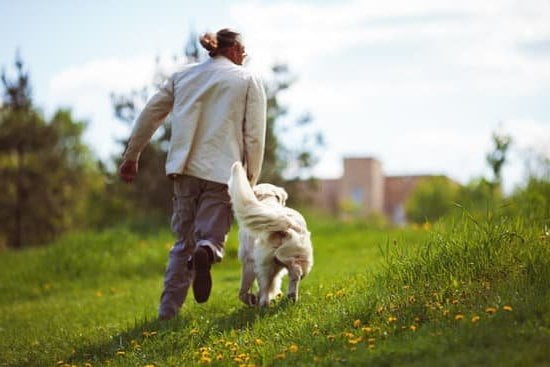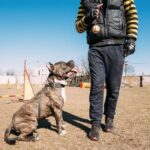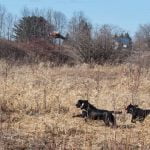Can you train a dog to track deer? The use of dogs for tracking various animals, including deer, has a long history that dates back centuries.
In this article, we will explore the origins of using dogs as tracking companions and how this practice has evolved over time. From the characteristics of a good tracking dog to the importance of proper training and understanding deer behavior, we will delve into everything you need to know about training a dog to track deer.
The history of using dogs as tracking companions is rich and varied, with different cultures and regions developing their own methods and techniques for training these valuable animals. As we delve into the origins of using dogs to track various animals, including deer, we will gain a deeper understanding of how this practice has evolved over time and the impact it has had on hunting and conservation efforts.
Proper training is crucial when it comes to teaching a dog to track deer. Without the right training techniques and methods, success in the field can be elusive.
Understanding not only the specific traits that make a good tracking dog but also the behavior and habits of deer is essential for effective training. As such, we will explore the significance of training and delve into specific techniques such as scent training and obedience training that are used to train a dog to track deer successfully.
Characteristics of a Good Tracking Dog
Dogs have been used for hunting purposes for thousands of years. When it comes to tracking deer, specific traits are crucial for a dog to be successful in this role. A strong sense of smell is perhaps the most important characteristic of a good tracking dog.
A dog’s olfactory sense is estimated to be tens of thousands to even 100 million times more sensitive than a human’s, making them highly adept at detecting scents. This ability enables them to pick up on the faintest traces left behind by deer and follow their trail accurately.
Endurance is another essential trait for a tracking dog. Tracking deer can involve covering great distances over various terrains, and a dog with good stamina will be able to stay focused and committed to the task at hand, even in challenging conditions. Additionally, agility plays a key role in a tracking dog’s effectiveness. The ability to navigate through dense forest areas or rugged landscapes while maintaining focus on the scent trail requires agility and physical coordination.
Training also plays an important role in developing these traits in a tracking dog. Through targeted training methods, dogs can enhance their natural abilities and become highly skilled at focusing their senses on tracking deer. Regardless of breed or individual characteristics, proper training is essential for optimizing a dog’s potential as an effective tracker.
| Trait | Description |
|---|---|
| Strong Sense of Smell | Dogs have an incredibly sensitive sense of smell that allows them to detect faint scents left behind by deer. |
| Endurance | Good stamina helps tracking dogs cover long distances over different terrains without losing focus. |
| Agility | Physical coordination and agility allow dogs to navigate through challenging landscapes while staying focused on the scent trail. |
The Importance of Training
When it comes to training a dog to track deer, the importance of proper training cannot be overstated. A well-trained tracking dog can make the difference between a successful hunt and coming home empty-handed.
Training not only ensures that the dog knows how to effectively track deer but also establishes a bond of trust and communication between the handler and the animal. This is crucial for working as a team in the field, especially when tracking deer in challenging terrains.
Proper training begins with laying a solid foundation of basic obedience skills, such as recall, sit, stay, and heel. These skills form the basis for more advanced training and are essential for ensuring that the dog is under control at all times during a tracking session.
Additionally, scent training is vital for teaching the dog to differentiate between different scents and follow the specific scent trail of a deer. This involves exposing the dog to deer scent and gradually increasing the difficulty of tracking exercises.
Consistent training is key to success when teaching a dog to track deer. Regular practice sessions improve the dog’s tracking skills while also strengthening the bond between handler and dog. It is important to remember that not all dogs are equally adept at tracking, so individualized training programs tailored to each dog’s abilities can maximize their potential for success in tracking deer.
| Key Point | Importance |
|---|---|
| Proper training | Crucial for effective tracking and establishing trust |
| Obedience training | Forms foundation for advanced tracking skills |
| Scent training | Teaches dogs to differentiate scents and follow specific trails |
Selecting the Right Breed
When it comes to training a dog to track deer, the breed of the dog plays a significant role in its success. Different breeds have different natural hunting instincts and abilities that make them well-suited for tracking deer. Understanding the characteristics and traits of various dog breeds will help in selecting the right breed for this specific purpose.
Characteristics to Look For
The ideal tracking dog should possess a strong sense of smell, endurance, agility, and intelligence. These traits are essential for effectively tracking and finding deer in various terrains and conditions. Breeds with these characteristics can be trained to become proficient tracking dogs with the proper guidance and training.
Popular Tracking Dog Breeds
Some of the most popular dog breeds known for their exceptional tracking abilities include Bloodhounds, Basset Hounds, Beagles, and German Shorthaired Pointers. These breeds have been historically used for hunting and tracking purposes due to their keen sense of smell and ability to work tirelessly on a scent trail. However, it’s important to note that any breed with the right attributes can be trained to track deer with patience, consistency, and proper training techniques.
Best Breeds for Tracking Deer
While many dog breeds have the potential to become proficient trackers, certain breeds are particularly well-suited for tracking deer specifically. The American Foxhound is renowned for its relentless pursuit when trailing game animals like deer over long distances.
On the other hand, the Bavarian Mountain Hound is known for its excellent scenting abilities in mountainous regions where deer often roam. By carefully selecting a breed that aligns with the specific terrain and conditions where deer hunting takes place, hunters can greatly increase their chances of success when utilizing a trained tracking dog.
Understanding Deer Behavior
Understanding the behavior and habits of deer is crucial for a tracking dog to be successful in their task. Deer are known to be cautious and easily spooked, making it important for a tracking dog to anticipate their movements and reactions.
Feeding Patterns and Routes
Deer are most active during dawn and dusk, known as crepuscular periods, when they travel from their bedding areas to feeding grounds. Understanding these patterns can help a tracking dog anticipate where deer are likely to be at different times of the day.
Bedding Areas
Deer often seek shelter in dense vegetation or areas with thick cover for resting during the day. Tracking dogs need to be aware of these potential bedding areas to effectively track deer that may be hiding or resting.
Reactions to Predators
Deer have evolved as prey animals, making them highly attentive to potential threats. They are keenly aware of their surroundings and can quickly detect the presence of predators, including humans and tracking dogs. This heightened sense of awareness means that tracking dogs need to approach with caution and remain as undetected as possible.
Understanding these aspects of deer behavior can help in training a dog to track deer effectively, as it provides valuable insights into the habits and tendencies of the animals they will be pursuing. By incorporating this knowledge into training methods, handlers can better prepare their dogs for successful tracking missions in the field.
Training Techniques and Methods
Training a dog to track deer requires specific techniques and methods to ensure success in the field. There are several key training approaches that can be used to develop a dog’s ability to track deer effectively.
Scent Training
Scent training is an essential aspect of preparing a dog to track deer. This involves exposing the dog to the scent of deer and teaching them how to recognize and follow it.
Scent training can be done through the use of scent trails or scent drags, where the dog is encouraged to follow a trail created using deer scent. Over time, the dog learns to associate this particular scent with the presence of deer, making it easier for them to track their prey.
Obedience Training
Obedience training is another crucial element in preparing a dog for tracking deer. A well-trained dog that responds promptly and reliably to commands from its handler will be better equipped to stay focused on the task at hand and follow instructions during a tracking expedition. Obedience training can involve basic commands such as sit, stay, come, and heel, as well as more advanced commands that are specific to tracking activities.
Simulation Training
Simulation training involves creating scenarios that mimic real-life hunting situations for the dog. By simulating encounters with deer in different environments and conditions, dogs can become familiar with the challenges they may face during actual tracking outings. This type of training helps them develop problem-solving skills and adaptability, which are essential traits for successful tracking dogs.
Overall, combining these various training techniques can help prepare a dog for effective deer tracking. Through consistent and structured training methods, handlers can significantly increase their chances of success when working with their dogs in pursuit of deer in the wild.
Real-Life Success Stories
When it comes to tracking deer, dogs have proven to be invaluable assets for hunters and conservationists alike. Their incredible sense of smell, agility, and endurance make them well-suited for this task. Through proper training and dedication, many dogs have been successfully trained to track deer, making a significant impact on hunting practices and wildlife conservation efforts.
Here are some real-life success stories of dogs that have been trained to track deer:
1. Hunter the Bloodhound: Hunter, a bloodhound from a long line of tracking champions, was trained by his owner Tom to track wounded deer during hunting season. His exceptional sense of smell and relentless determination helped hunters recover injured deer quickly and ethically, reducing suffering in the wild.
2. Lucy the German Shorthaired Pointer: Lucy, a German Shorthaired Pointer, underwent rigorous scent training with her handler Sarah. Lucy’s ability to track deer was instrumental in aiding wildlife biologists in studying deer behavior and migration patterns for conservation purposes.
3. Max the Black Labrador Retriever: Max was trained by a team of professional dog trainers to track poached deer in collaboration with law enforcement agencies. His tracking skills led to several successful arrests of poachers, sending a clear message about the consequences of illegal hunting activities.
These stories are just a few examples of how well-trained tracking dogs have made a positive impact on both hunting practices and wildlife conservation efforts.
- The partnership between tracking dogs and hunters has led to more ethical and efficient harvesting of game animals.
- Conservation organizations can gather valuable data about deer populations and behavior through the assistance of tracking dogs.
- Law enforcement agencies can combat illegal hunting activities more effectively with the help of trained tracking dogs.
Overall, these stories highlight the important role that properly trained tracking dogs play in ensuring sustainable hunting practices while contributing to the preservation of wildlife populations.
- Proper training is crucial in developing a dog’s tracking abilities.
- Consistent reinforcement and practice are necessary for maintaining a dog’s tracking skills.
- Understanding the specific behavior and habitat preferences of deer is essential for effective tracking.
The Legal and Ethical Considerations
In conclusion, training a dog to track deer is a complex and multi-faceted process that requires careful consideration of several factors. The history of tracking dogs shows how this practice has evolved over time, and today, there are specific traits that make a dog well-suited for tracking deer. Proper training is crucial as it can make the difference between success and failure in the field. Understanding deer behavior is also essential for a tracking dog to be successful.
When it comes to selecting the right breed for tracking deer, there are various dog breeds that are known for their tracking abilities, and each has its own strengths and considerations. Additionally, training techniques such as scent training and obedience training plays a crucial role in preparing a dog for tracking deer effectively. Real-life success stories showcase the impact that trained tracking dogs can have on hunting and conservation efforts.
Moreover, legal and ethical considerations should not be overlooked when using a tracking dog for deer hunting. It is important to understand any regulations or restrictions that may apply to this practice and ensure that the use of a tracking dog complies with ethical standards. Therefore, while it is indeed possible to train a dog to track deer, it involves careful planning, proper training, understanding deer behavior, selecting the right breed, and adhering to legal and ethical considerations.
Frequently Asked Questions
How Do You Train a Dog to Find Dead Deer?
Training a dog to find dead deer requires patience, consistency, and positive reinforcement. Start by introducing the scent of a dead deer to the dog and gradually train them to recognize and locate it.
Is It Legal to Track Deer With Dogs?
The legality of tracking deer with dogs varies by state and local regulations. In some areas, using dogs to track deer may be permitted during certain hunting seasons, while in others it may be illegal.
What Kind of Dogs Are Good for Tracking Deer?
Breeds that are commonly used for tracking deer include bloodhounds, bluetick coonhounds, and other scent hound breeds. These dogs have a strong sense of smell and determination, making them well-suited for tracking deer over long distances.

Welcome to the blog! I am a professional dog trainer and have been working with dogs for many years. In this blog, I will be discussing various topics related to dog training, including tips, tricks, and advice. I hope you find this information helpful and informative. Thanks for reading!





